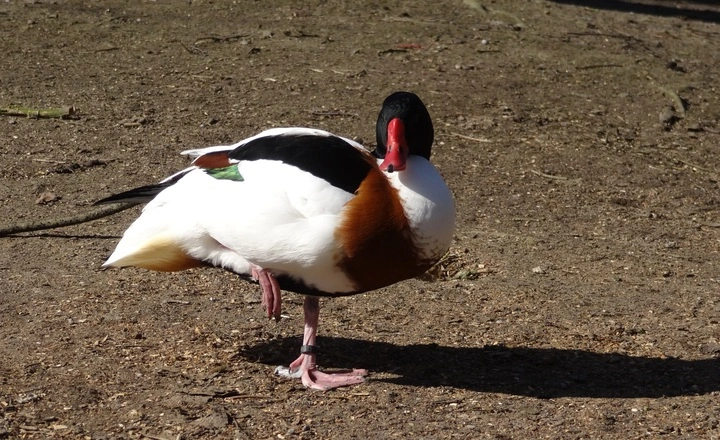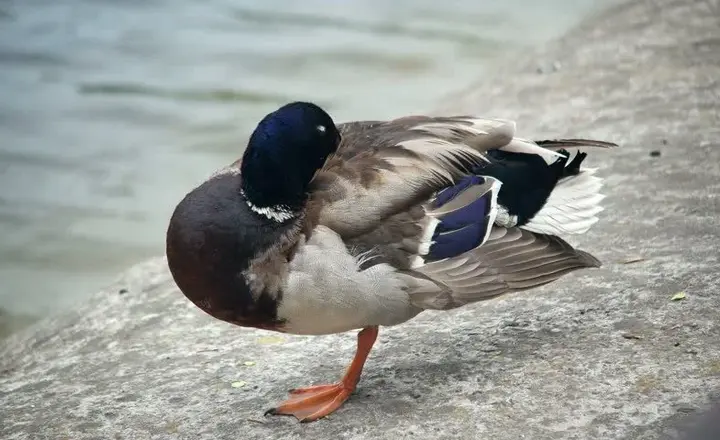Ducks are often seen standing on one leg, a behavior that has intrigued bird watchers and scientists alike. This behavior is not exclusive to ducks; it is observed in various bird species. Here is a comprehensive guide to understanding Why Do Ducks Stand On One Leg?
Why do Ducks Stand On One Leg?
Ducks often stand on one leg as a way to regulate their body temperature. This behavior, known as unipedal resting, allows ducks to expose less of their body to the cold ground, helping them retain heat more efficiently.
By lifting one leg off the ground, ducks can reduce heat loss and maintain a comfortable body temperature even in colder environments.
Standing on one leg may also help ducks conserve energy while resting. By balancing on just one leg, ducks can relax their muscles and reduce strain on their bodies during periods of rest or sleep.
This posture enables them to take short breaks without fully lying down, allowing them to quickly resume activity if needed while conserving energy at the same time. Standing on one leg is a fascinating adaptation that serves multiple purposes for these unique and resourceful birds.
Conserving Heat & Regulating Temperature By Standing on One Leg
Birds have evolved remarkable adaptations to conserve heat and regulate their body temperature. Such adaptation is the rete mirabile, a network of arteries that weave throughout their bodies to help maintain blood temperature.
By standing on one leg, birds are able to reduce heat loss and keep themselves warmer. This behavior may seem unusual, but it is a natural way for birds to conserve energy and stay comfortable in various habitats.
Contrary to common belief, standing on one leg does not cause muscle or tissue damage for birds like ducks. In fact, they alternate legs regularly to give each limb a rest and prevent any potential harm.
Ducks use other methods such as turning towards or away from the sun, standing in water, and fluffing out their feathers to regulate their body temperature effectively. These behaviors showcase the incredible adaptability of birds in maintaining their internal heat balance in different environments.
Do Ducks Prefer to Sleep Standing Up on One Leg?
Yes, they do prefer to sleep standing up on one leg. This behavior, known as unipedal resting, is a common adaptation among birds to prevent excessive heat loss, especially on cold winter days.
By standing on one leg or turning their face towards the sun, ducks are able to thermoregulate and keep themselves warm during the night. This habit is not unique to ducks but is also observed in other bird species such as pigeons, parrots, flamingos, and geese.
While the feathers of ducks provide some insulation, sleeping on one leg helps them conserve heat more effectively. Just like humans wrap themselves in blankets to stay warm, ducks utilize this posture to maintain their body temperature.

It may seem like an uncomfortable position for humans, it has proven to be an effective strategy for many bird species to survive harsh winter conditions.
Different Theories Supporting Unipedal Resting in Ducks
The behavior of ducks and other birds standing on one leg has fascinated bird admirers for years, leading to various theories being proposed to explain this phenomenon.
One theory suggests that birds adopt this posture to reduce fatigue in one leg after remaining active throughout the day. Another theory posits that standing on one leg allows birds to stay alert and ready for potential threats, aiding in their self-preservation.
The idea of camouflage is put forth as a reason for this behavior, with one leg blending in with the surroundings more effectively than two legs, potentially helping prey birds evade predators.
Among these theories, one of the most widely accepted explanations is that birds, including ducks, stand on one leg to conserve heat and regulate their body temperature.
By minimizing the surface area exposed to the cold ground, birds can prevent heat loss and maintain their internal warmth more efficiently.
This adaptive behavior showcases how animals have evolved unique strategies to survive and thrive in their environments, shedding light on the fascinating world of avian biology.
Can a Ducks Survive With one Leg?
Ducks are remarkably resilient animals and can indeed survive with just one leg. While they may face challenges in walking and competing for food, they have adapted mechanisms to cope with these difficulties.
With the limitations imposed by having only one leg, ducks have shown remarkable adaptability and resourcefulness in overcoming these obstacles.

Their strong survival instincts and ability to adjust their behavior according to their circumstances, ducks can continue to thrive even with a physical impairment. Their ability to persevere in the face of adversity is a testament to their resilience and adaptability as a species.
Conclusion
The behavior of ducks standing on one leg is a fascinating phenomenon that has intrigued scientists and researchers for decades. While there are various theories to explain this behavior, including conserving body heat and promoting relaxation, the exact reason remains uncertain.
By studying the behaviors of ducks in their natural habitat and conducting further research, we may gain a deeper understanding of why they exhibit this unique behavior.
FAQs
Why do birds stretch when they see you?
When they see you, they may perceive you as a potential threat or source of excitement, prompting them to engage in stretching as part of their instinctual response.
Why does my bird bite me softly?
By gently nipping at you, your bird may be signaling that they want attention, are feeling anxious, or are trying to tell you that they are not in the mood for interaction.
